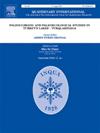Vegetation and climate dynamics in a 16,600-year marine sequence offshore Mozambique in Delagoa Bight, south-eastern Africa
IF 1.8
3区 地球科学
Q3 GEOGRAPHY, PHYSICAL
引用次数: 0
Abstract
Few records of long-term vegetation dynamics and climate variability exist from coastal southeastern Africa. This study presents a new high-resolution marine pollen record (GeoB20615-2) from southern Mozambique, spanning the past c. 16,600 years. The chronology is based on a Bayesian age-depth model constructed using twelve radiocarbon dates on marine and terrestrial remains. Prior to c. 15,000 cal BP, pollen from ericaceous shrubs was prevalent, indicating low temperatures, while forest or woodland pollen taxa were minimal or absent. From c. 13,000 cal BP onwards, the record shows a gradual increase in savanna pollen taxa such as Spirostachys and Burkea, suggesting climatic warming. Pollen of Spirostachys, a woodland tree thriving in dry, warm regions, continues to increase into the early Holocene, between c. 11,200 and 9200 cal BP. After c. 9200 cal BP, a decline in Spirostachys pollen corresponds with a rise in Podocarpus pollen during a phase of high sea levels, indicating a potential expansion in coastal and/or montane forests, possibly reflecting increased moisture availability. From c. 3500 cal BP, Podocarpus pollen declines, likely due to more arid conditions, as indicated by a concomitant increase in Chenopodiaceae/Amaranthaceae, Asteraceae, and Spirostachys pollen. The youngest section of the profile is potentially affected by sediment mixing from c. 250 cal BP onwards. The section reveals the impact of European colonialists, with the appearance of neophytic pine pollen, and an increase in indigenous Alchornea, a disturbance indicator. The pollen results are in good agreement with terrestrial palynological records from the Indian Ocean Coastal Belt Biome such as Lake Eteza in northeastern South Africa. The GeoB20615-2 record contributes greater understanding of long-term vegetation dynamics and associated climatic shifts in the Indian Ocean Coastal Belt Biome.
非洲东南部德拉戈阿湾莫桑比克近海16600年海洋序列的植被和气候动态
非洲东南部沿海地区很少有长期植被动态和气候变率的记录。本研究提出了一个新的高分辨率海洋花粉记录(GeoB20615-2),来自莫桑比克南部,跨越了约16,600年。该年表基于贝叶斯年龄深度模型,该模型使用了12个海洋和陆地遗迹的放射性碳年代。在c. 15,000 cal BP之前,白垩灌木花粉普遍存在,表明气温较低,而森林或林地花粉类群很少或不存在。从公元前13000 cal BP开始,记录显示热带草原花粉分类群(如Spirostachys和Burkea)逐渐增加,表明气候变暖。Spirostachys是一种生长在干燥、温暖地区的林地树木,其花粉在全新世早期(约11,200至9200 cal BP)继续增加。在约9200 cal BP之后,Spirostachys花粉的减少与Podocarpus花粉在高海平面阶段的增加相对应,表明沿海和/或山地森林的潜在扩张,可能反映了水分可用性的增加。从大约3500 cal BP开始,Podocarpus的花粉数量下降,可能是由于更干旱的条件,与此同时Chenopodiaceae/Amaranthaceae, Asteraceae和Spirostachys的花粉数量增加。剖面最年轻的部分可能受到约250 cal BP以后沉积物混合的影响。该部分揭示了欧洲殖民者的影响,新生松花粉的出现,以及土著Alchornea(一种干扰指标)的增加。研究结果与南非东北部Eteza湖等印度洋海岸带生物群落的陆地孢粉学记录吻合较好。GeoB20615-2记录有助于更好地了解印度洋海岸带生物群系的长期植被动态和相关气候变化。
本文章由计算机程序翻译,如有差异,请以英文原文为准。
求助全文
约1分钟内获得全文
求助全文
来源期刊

Quaternary International
地学-地球科学综合
CiteScore
5.60
自引率
4.50%
发文量
336
审稿时长
3 months
期刊介绍:
Quaternary International is the official journal of the International Union for Quaternary Research. The objectives are to publish a high quality scientific journal under the auspices of the premier Quaternary association that reflects the interdisciplinary nature of INQUA and records recent advances in Quaternary science that appeal to a wide audience.
This series will encompass all the full spectrum of the physical and natural sciences that are commonly employed in solving Quaternary problems. The policy is to publish peer refereed collected research papers from symposia, workshops and meetings sponsored by INQUA. In addition, other organizations may request publication of their collected works pertaining to the Quaternary.
 求助内容:
求助内容: 应助结果提醒方式:
应助结果提醒方式:


